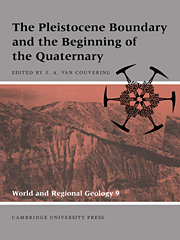Book contents
- Frontmatter
- Contents
- List of contributors
- Preface: the new Pleistocene
- Foreword
- Part I Definition of the base of the Quaternary
- Part II Characterization of the Pleistocene boundary-stratotype
- 2 The Pliocene–Pleistocene boundary-stratotype at Vrica, Italy
- 3 The magnetostratigraphy of the Vrica section, Italy, and its correlation with the Plio–Pleistocene of the Boso Peninsula, Japan
- 4 Comparison of the laminated units at Vrica and deep-sea sapropels from the eastern Mediterranean
- 5 Calcareous nannofossil biochronology and the Pliocene–Pleistocene boundary
- 6 Diatom microfossils from the Vrica section
- Part III The paleontological context of the Pleistocene boundary
- Part IV The Pleistocene boundary in regional sequences
- Index
3 - The magnetostratigraphy of the Vrica section, Italy, and its correlation with the Plio–Pleistocene of the Boso Peninsula, Japan
Published online by Cambridge University Press: 10 November 2009
- Frontmatter
- Contents
- List of contributors
- Preface: the new Pleistocene
- Foreword
- Part I Definition of the base of the Quaternary
- Part II Characterization of the Pleistocene boundary-stratotype
- 2 The Pliocene–Pleistocene boundary-stratotype at Vrica, Italy
- 3 The magnetostratigraphy of the Vrica section, Italy, and its correlation with the Plio–Pleistocene of the Boso Peninsula, Japan
- 4 Comparison of the laminated units at Vrica and deep-sea sapropels from the eastern Mediterranean
- 5 Calcareous nannofossil biochronology and the Pliocene–Pleistocene boundary
- 6 Diatom microfossils from the Vrica section
- Part III The paleontological context of the Pleistocene boundary
- Part IV The Pleistocene boundary in regional sequences
- Index
Summary
Introduction
During the XI INQUA Congress in Moscow in 1982, the INQUA Subcommission 1-d, “Pliocene–Pleistocene Boundary,” and the working group of IGCP Project 41, “Neogene/Quaternary Boundary,” jointly proposed that the section at Vrica in Calabria, southern Italy, be adopted as the Pliocene–Pleistocene boundary-stratotype. With the acceptance of that proposal by the IUGS International Commission on Stratigraphy (Nikiforova and Alekseev, Chapter 1, this volume), the type horizon designated at Vrica has been extended to Plio–Pleistocene sections around the world.
On the other side of the globe from Vrica, many marine sedimentary sections that are continuous through the Pliocene–Pleistocene transition are well exposed along the Pacific coast. Among these the Boso Peninsula in central Japan is one of the best places to study the Pliocene–Pleistocene transition (Itihara et al., Chapter 24, this volume). In recent years we have worked to correlate the Plio–Pleistocene sections of Calabria with those of the Boso Peninsula on the basis of geomagnetic reversals and planktonic microfossil events. We began our study of the Vrica section in 1976, shortly after the initial reports from the Italian team led by Raimondo Selli (1975; Selli et al., 1977). In 1977, in meetings at Birmingham, England, and at Dushanbe, Tadjikistan, USSR, we responded to the urgent request of the IGCP-41 working group and reported on a preliminary study of the paleomagnetic polarity sequence of the Vrica section, although the sampling interval had been inadequate to satisfactorily resolve the magnetostratigraphy (Nakagawa et al., 1980).
- Type
- Chapter
- Information
- Publisher: Cambridge University PressPrint publication year: 1996
- 2
- Cited by



